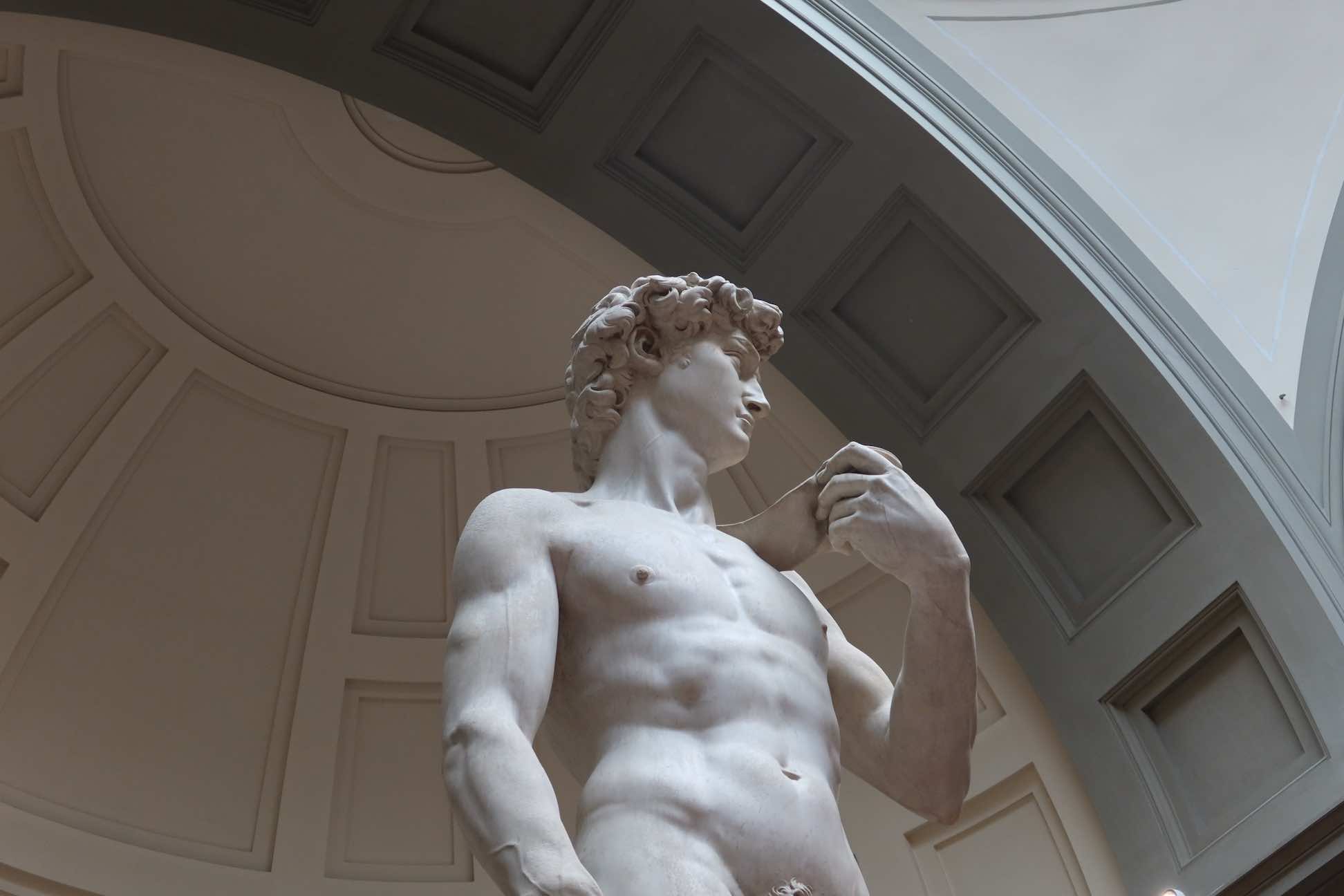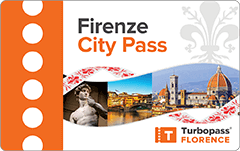- Sign up & get a FREE ebook Subscribe Today!
- Florencewise Home Page
- bargello museum
See Plenty of Michelangelo and More at Florence's Bargello Museum
You've visited the Uffizi Gallery, the Palazzo Vecchio, Galleria dell'Accademia... Where next?
Bargello Museum is the Florence art museum you (probably) didn't know existed, and might just become your favorite!
Everything you need to know about visiting the Bargello National Museum in Florence
The Museo Nazionale del Bargello is a smaller museum with a remarkable collection of Italian Renaissance sculptures.
Michelangelo, Luca della Robbia, Donatello... If you can name a famous sculptor working in Italy from the middle of the 14th century to the 16th century, their art is probably here!
Even the beautiful Bargello Museum building itself has a long, fascinating past.
After you've finished reading this guide, you'll wonder why most visitors to the city skip this splendid museum.
And you'll be glad you didn't!
On this page we'll be going over:
- The history of the Palazzo del Bargello
- The establishment of the Museo Nazionale del Bargello
- Is it worth visiting the Bargello Museum?
- What there is to see in the Museo Nazionale del Bargello
- How to visit the Bargello National Museum
The history of the Palazzo del Bargello
The Bargello Museum has gone by many names over the years!
Construction started on the palace in 1255 on the street now known as Via del Proconsolo.
It was originally a two-story building with an open courtyard built next to the existing Volognana Tower.
After a fire in 1323, a third floor was added, you can spot where this addition starts by looking for the slightly smaller bricks on the top floors.
The original purpose of the palace was as a residence for the Capitano del Popolo (translating to 'Captain of the People').
During this time, it was known as Palazzo del Popolo ('Palace of the People').
The Council of Justice and Police Headquarters
The Podestà, the Florence's Council of Justice, moved in around 1261.
In 1299, the crenellated sandstone fortress's architectural style inspired the design of Palazzo Vecchio.
The Medici family moved the Florence city magistrate's office and transformed the palace into a residence for the police chief of Florence in the middle of the sixteenth century.
This is when the building received the name Palazzo del Bargello.
This impressive building soon became a prison.
Executions took place in the inner courtyard of Palazzo del Bargello until 1786 when Grand Duke Peter Leopold abolished capital punishment.
Almost one hundred years later in 1859, the Governor of Tuscany decided that Palazzo del Bargello should cease to be police headquarters and be a museum.
The Museo Nazionale del Bargello was born!
The establishment of the Museo Nazionale del Bargello
Subsequently, the palace was enriched with a grand Italian Renaissance sculpture collection.
There are also a few Gothic and Baroque masterpieces.
The Bargello National Museum officially opened as a museum for sculpture in 1865.
The formation of the modern Kingdom of Italy only occurred four years prior, so it was the first of the national museums.
Aside from sculpture, the museum also displays a wealth of other minor arts including tapestries, textiles, waxes, enamels, medals, seals, and furniture.
Most of these pieces date from ancient times to the 17th century.
Many artworks are from the Medici family collection as well as private donors.
Is it worth visiting the Bargello Museum?
Yes, absolutely!
It houses some of the most important Renaissance sculptures in Florence.
Many agree that its masterpieces are on par with the sculptures exhibited in the Uffizi Gallery.
The Galleria dell'Accademia might house Michelangelo's most iconic sculpture, the David, but there is a significant collection of his works in the Bargello Museum.
Plus, you can admire his works (and those of other Renaissance artists like Donatello, Benvenuto Cellini, and the Della Robbia family) without the crowds.
Despite the incredible collection, the Bargello is not as popular as it deserves to be, so you can pretty much always guarantee that the galleries will be quiet.
Check out our top tips for making the most of your time in Florence:
What there is to see inside the Museo Nazionale del Bargello
The masterpieces in the Bargello Museum span three floors.
On the ground floor, you'll find the beautiful courtyard, temporary exhibitions, and the Michelangelo Room with many important Renaissance sculptures by other artists.
On the first floor, there are nine rooms including the Donatello Room.
Amongst these rooms are a chapel, sacristy, and other halls and walkways covered with art collections.
Finally, on the second floor, there are eight rooms.
The Bronze Hall, the Armory, and the Tower Hall filled with textiles and tapestries are here.
The Medici Collections are also in a room on the top floor.
Works by Michelangelo
Many would argue that Italian Renaissance sculpture wouldn't be what it is without Michelangelo.
The Museo Nazionale del Bargello proudly owns four of his masterpieces!
Bacchus (1497) depicts the Roman god of wine in marble in a somewhat drunken pose.
It's a larger-than-life size statue from Michelangelo's early career.
He also created the marble bust of Brutus (1540) with a heroic profile.
Pitti Tondo (1507) is an unfinished relief of the Madonna and child set within a round piece of marble.
Michelangelo worked on it while completing his famous David piece but left for Rome before finishing.
The fourth piece in this collection is David-Apollo (1530), also unfinished.
Michelangelo never named this marble statue so historical sources disagree about the subject.
Giorgio Vasari stated it was an Apollo reaching for a quiver, but the inventory records for Cosimo I de Medici list it as David, so now it is known as both!
 Seeing earlier works gives hints to Michelangelo's later genius which is one of the many reasons I love this collection!
Seeing earlier works gives hints to Michelangelo's later genius which is one of the many reasons I love this collection!Works by Donatello
Donatello created his marble David in 1409 for the Florence Duomo.
When the statue was moved to the Palazzo Vecchio in 1416, he added the Latin inscription, "Pro patria fortiter dimicantibus etiam adversus terribilissimos hostes dii praestant auxilium."
This translates to, "To those who fight bravely for the fatherland the gods lend aid even against the most terrible foes."
His bronze David (circa 1440's) is noted as being the first freestanding bronze Renaissance sculpture.
 The story of David and Goliath served as inspiration for many artists during the Renaissance, and Donatello's bronze depiction is a particularly good example
The story of David and Goliath served as inspiration for many artists during the Renaissance, and Donatello's bronze depiction is a particularly good exampleBoth of Donatello's Davids are standing on the head of Goliath.
One notable difference is that the marble version is clothed while the bronze version is naked.
Visit the Loggia on the first floor for many other bronze sculptures crafted in the sixteenth century for the Medici Villa of Castillo.
 I always spend quite a bit of time in the Loggia, the ceiling details are fascinating and there is a lovely spot to sit and take in your surroundings
I always spend quite a bit of time in the Loggia, the ceiling details are fascinating and there is a lovely spot to sit and take in your surroundingsAlso found in the large Hall of Donatello is Saint George (1417).
This marble statue of the armored saint with his sword used to stand outside the Orsanmichele church in Florence until someone threw a stone at the sculpture and broke its nose.
No matter what season you visit Florence, here are 4 essential things we recommend never leaving home without:
Disclosure: If you make a purchase through a link on this page, I may receive a small commission - at no extra cost to you. Thank you for supporting my site!
Works by Cellini
Models of Perseus are two preparatory sculptures by Benvenuto Cellini.
He made the wax and bronze models not only as an exercise, but also to convince Cosimo I de Medici to commission the work.
He did, and Perseus with the Head of Medusa (1554) currently resides in the Loggia dei Lanzi in Piazza della Signoria.
Cellini's 1548 larger-than-life bronze bust of Cosimo I de Medici is another important piece in the museum, although the Duke never appreciated it.
Other notable works
One of the most celebrated sculptures by Giambologna is in the Bargello, the lifesize Flying Mercury (1580).
This bronze Mannerist statue depicts the nude God soaring and is supposed to be viewed from all angles.
The lightness and balance of this piece are truly remarkable!
Andrea del Verrocchio's version of David (1475) also resides in the Bargello museum.
It's a bronze statue of a youthful figure, and some say he modeled this sculpture on his student Leonardo da Vinci.
 Verrocchio's sculpture of David after killing Goliath is more youthful and posed than others, but no less impressive!
Verrocchio's sculpture of David after killing Goliath is more youthful and posed than others, but no less impressive!St John the Baptist (1442) by Desiderio da Settignano and Donatello is strikingly gaunt.
The famous religious figure is depicted in marble with a metal cross and a halo.
It was attributed solely to Donatello, but the style is more consistent with Desiderio da Settignano's work.
In 1401, seven artists created reliefs of the Sacrifice of Isaac for a competition.
They all hoped to win the commission to design the second bronze door for the Baptistery of Florence.
The competition entries of Filippo Brunelleschi and Lorenzo Ghiberti are both in this building.
Unfortunately for Brunelleschi, Ghiberti won the commission!
Two rooms in the museum are dedicated to the works of Luca della Robbia and his family.
They created many terracotta sculptures glazed in blue and white.
Bust of a Saint (1470) is one of his most notable pieces which adheres to this signature style.
How to visit the Bargello National Museum
The Bargello is open every day except Tuesday, with visits starting from 8:15AM.
Closing time varies according to the season so be sure to check on the official website for the specific opening hours that correspond to when you're visiting.
You can purchase single entry tickets just for the Bargello museum (reduced tickets are available) or a combined entrance ticket which is valid for 3 days.
The gives you access to the Bargello Museum, Medici Chapels, Orsanmichele, Palazzo Davanzati, and the Casa Martelli, with one entry to each site over the 3 days.
You can also visit the Bargello Museum for free on the first Sunday of every month, plus a select few other days throughout the year.
If you're interested in finding out more about the collection, the museum offers free 60-minute thematic tours that focus on a specific room every Monday, Wednesday, Thursday, Friday, and Saturday at 11AM.
These tours are first come, first serve and allow a maximum of fifteen people, so check at the ticket desk when you enter if there are spaces available for you to join.
 There are so many meaningful pieces, like this symbolic version of Florence conquering Pisa, that having a guide will add a lot to your visit
There are so many meaningful pieces, like this symbolic version of Florence conquering Pisa, that having a guide will add a lot to your visitIf you want to visit Museo Nazionale del Bargello during the peak summer season, I would advise you to book a ticket in advance.
Similarly, joining a guided tour is a great way to fully appreciate the wonders of this collection.
Otherwise, pre-booking your ticket is generally not necessary.
The ticket office is just off the courtyard and there is rarely a queue.
Florencewise's Top Travel Resources
Ready to book your trip to Florence? Take a look at these helpful links to companies we use and trust:
- Keep your travel spending simple with the Wise card, which removes all the worry about exchange rates and high transaction fees all over the world
- Search for and book your perfect accommodation
- Our complete guide to what to pack for Florence
- The number one travel accessory, a multi-point travel adapter and voltage converter
- Browse a huge range of tours in Florence and beyond
- Experience unique tours and special access to Florence's most popular sights
- Protect yourself with comprehensive travel insurance
Within this post there are some affiliate links for products and services. For more details about our affiliate policy click here.
Receive the latest Florence news, travel tips, insights and more!
Simply sign-up today for our free newsletter:
We are committed to respecting your data. Click for our Privacy Policy.
Comments? Questions? Suggestions?
Please come over to the private Facebook group and join in the conversation.
You will often find me there, happy to answer your questions / comments!
You will also meet other Florence lovers and experts, too.
What are you waiting for?


























